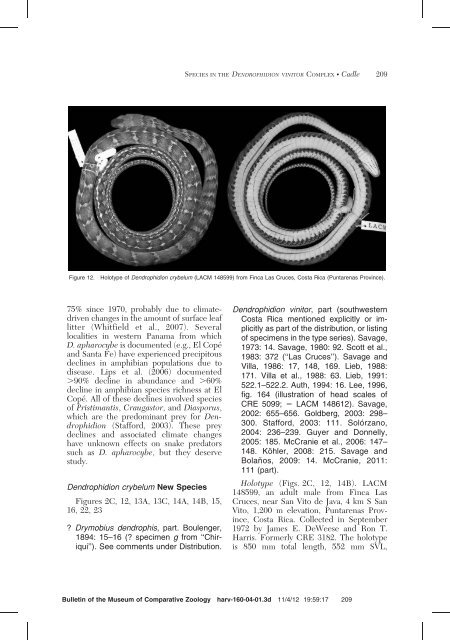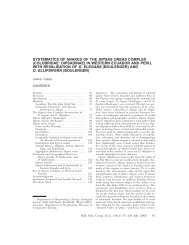cryptic species within the dendrophidion vinitor complex in middle ...
cryptic species within the dendrophidion vinitor complex in middle ...
cryptic species within the dendrophidion vinitor complex in middle ...
You also want an ePaper? Increase the reach of your titles
YUMPU automatically turns print PDFs into web optimized ePapers that Google loves.
SPECIES IN THE DENDROPHIDION VINITOR COMPLEX N Cadle 209<br />
Figure 12.<br />
Holotype of Dendrophidion crybelum (LACM 148599) from F<strong>in</strong>ca Las Cruces, Costa Rica (Puntarenas Prov<strong>in</strong>ce).<br />
75% s<strong>in</strong>ce 1970, probably due to climatedriven<br />
changes <strong>in</strong> <strong>the</strong> amount of surface leaf<br />
litter (Whitfield et al., 2007). Several<br />
localities <strong>in</strong> western Panama from which<br />
D. apharocybe is documented (e.g., El Copé<br />
and Santa Fe) have experienced precipitous<br />
decl<strong>in</strong>es <strong>in</strong> amphibian populations due to<br />
disease. Lips et al. (2006) documented<br />
.90% decl<strong>in</strong>e <strong>in</strong> abundance and .60%<br />
decl<strong>in</strong>e <strong>in</strong> amphibian <strong>species</strong> richness at El<br />
Copé. All of <strong>the</strong>se decl<strong>in</strong>es <strong>in</strong>volved <strong>species</strong><br />
of Pristimantis, Craugastor, and Diasporus,<br />
which are <strong>the</strong> predom<strong>in</strong>ant prey for Dendrophidion<br />
(Stafford, 2003). These prey<br />
decl<strong>in</strong>es and associated climate changes<br />
have unknown effects on snake predators<br />
such as D. apharocybe, but <strong>the</strong>y deserve<br />
study.<br />
Dendrophidion crybelum New Species<br />
Figures 2C, 12, 13A, 13C, 14A, 14B, 15,<br />
16, 22, 23<br />
? Drymobius dendrophis, part. Boulenger,<br />
1894: 15–16 (? specimen g from ‘‘Chiriqui’’).<br />
See comments under Distribution.<br />
Dendrophidion <strong>v<strong>in</strong>itor</strong>, part (southwestern<br />
Costa Rica mentioned explicitly or implicitly<br />
as part of <strong>the</strong> distribution, or list<strong>in</strong>g<br />
of specimens <strong>in</strong> <strong>the</strong> type series). Savage,<br />
1973: 14. Savage, 1980: 92. Scott et al.,<br />
1983: 372 (‘‘Las Cruces’’). Savage and<br />
Villa, 1986: 17, 148, 169. Lieb, 1988:<br />
171. Villa et al., 1988: 63. Lieb, 1991:<br />
522.1–522.2. Auth, 1994: 16. Lee, 1996,<br />
fig. 164 (illustration of head scales of<br />
CRE 5099; 5 LACM 148612). Savage,<br />
2002: 655–656. Goldberg, 2003: 298–<br />
300. Stafford, 2003: 111. Solórzano,<br />
2004: 236–239. Guyer and Donnelly,<br />
2005: 185. McCranie et al., 2006: 147–<br />
148. Köhler, 2008: 215. Savage and<br />
Bolaños, 2009: 14. McCranie, 2011:<br />
111 (part).<br />
Holotype (Figs. 2C, 12, 14B). LACM<br />
148599, an adult male from F<strong>in</strong>ca Las<br />
Cruces, near San Vito de Java, 4 km S San<br />
Vito, 1,200 m elevation, Puntarenas Prov<strong>in</strong>ce,<br />
Costa Rica. Collected <strong>in</strong> September<br />
1972 by James E. DeWeese and Ron T.<br />
Harris. Formerly CRE 3182. The holotype<br />
is 850 mm total length, 552 mm SVL,<br />
Bullet<strong>in</strong> of <strong>the</strong> Museum of Comparative Zoology harv-160-04-01.3d 11/4/12 19:59:17 209







